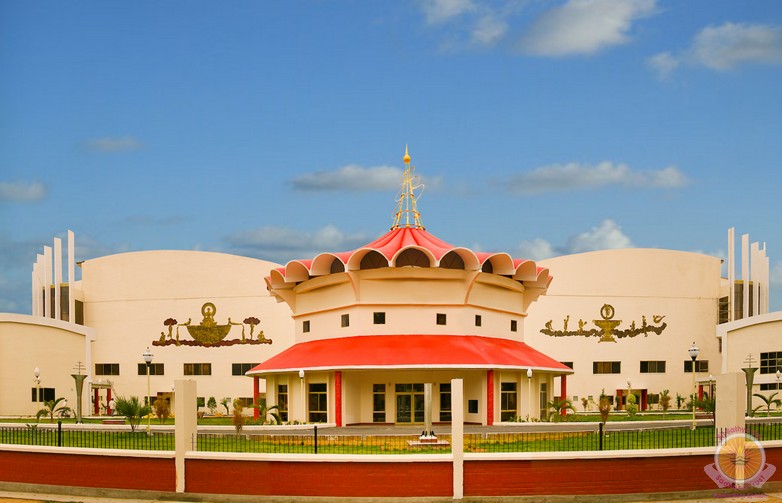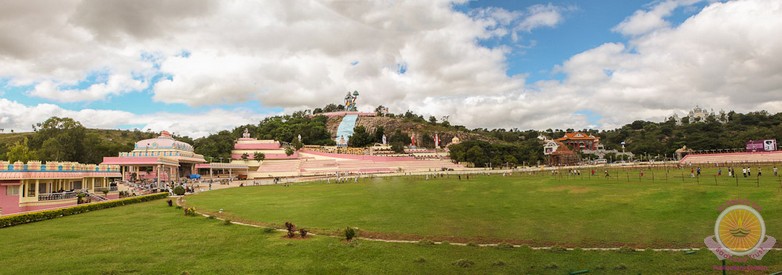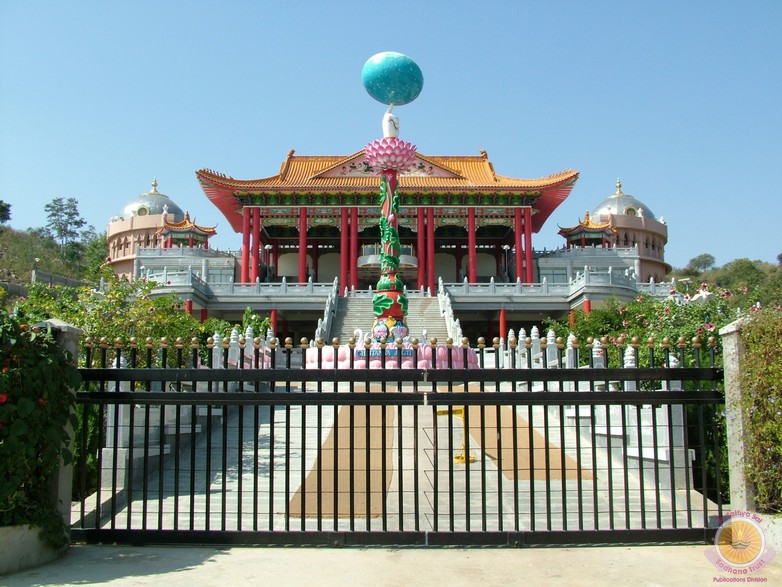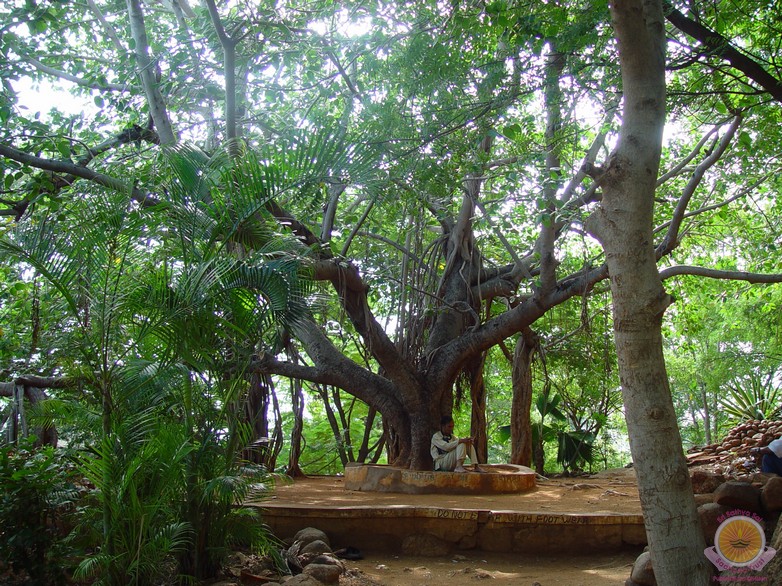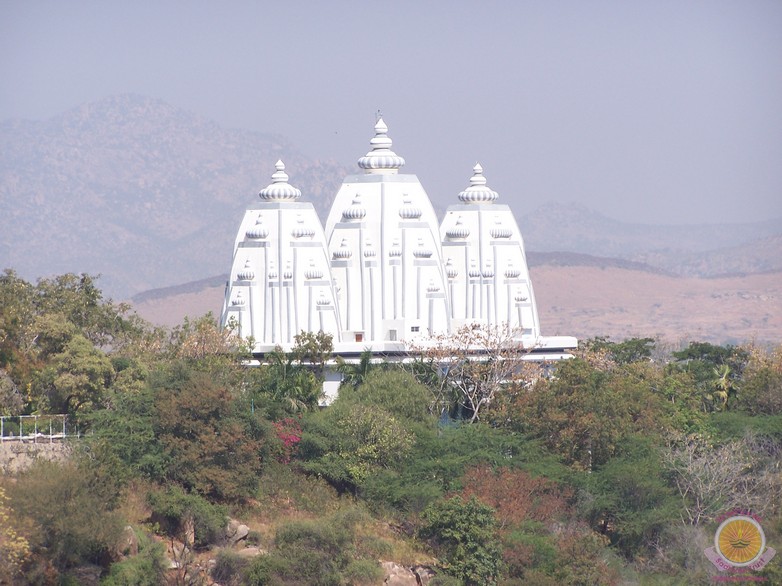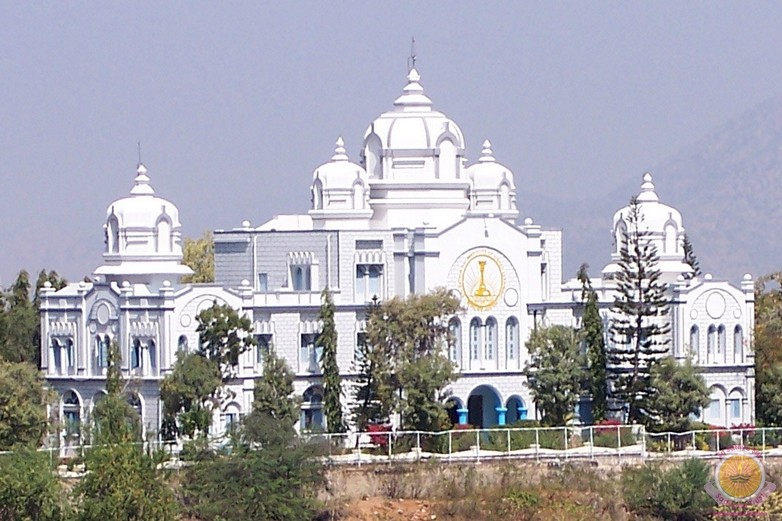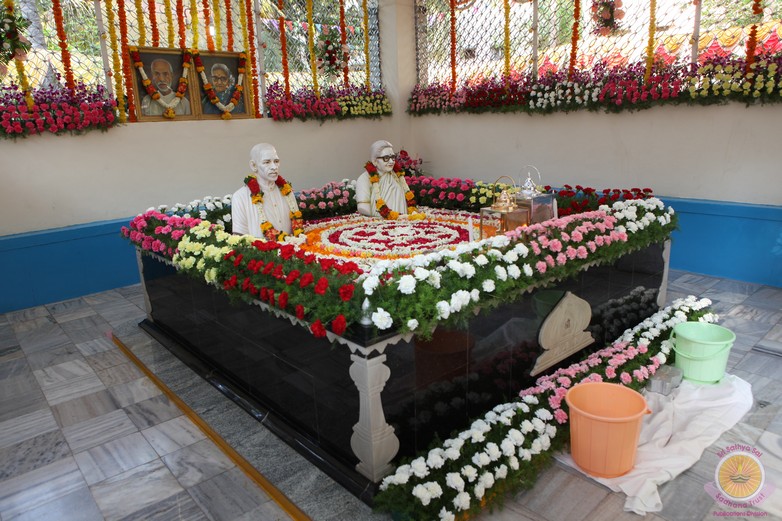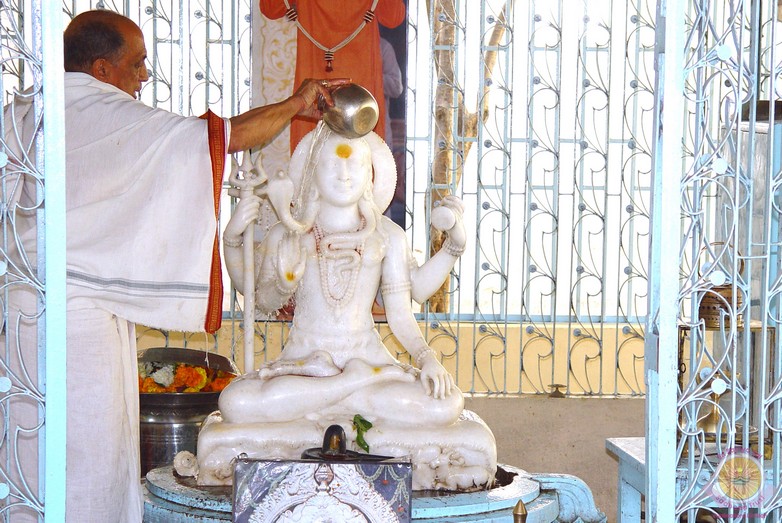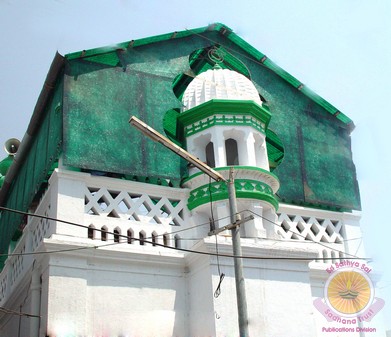We show you the main attractions outside the ashram in Puttaparthy beginning from the south, where you probably will first come into Puttaparthy. Click any picture to see an enlarged version.
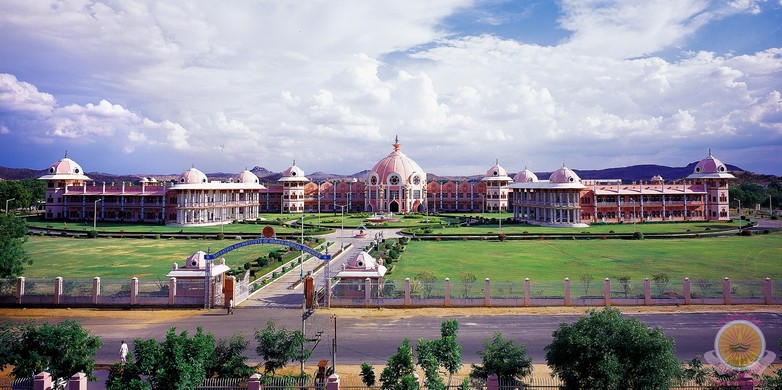 Sri
Sathya Sai Institute of Higher Medical Sciences top
of page
Sri
Sathya Sai Institute of Higher Medical Sciences top
of page
The building isa beautiful and breath-taking sight. It is designed with
the very best of ancient and modern architecture. The dome-shaped central
hall of the hospital is decorated with a magnificent chandelier. it was
opened on the occasion of Bhagawan's 66th Birthday in 1991. The hospital
currently has five departments: cardiology, CTVS, urology, nephrology
and ophthalmology. This unique hospital caters to all sections of the
population from any part of the world, medical priority being the sole
consideration. All services are free. The construction of 15,000 square
metres with facilities for 300 beds in less than a year is itself a miracle.
All the supporting facilities and equipments of the most sophisticated
kind have been provided. A very technically competent assembly of doctors
and administrators manage the project, combining a rigorous pragmatism
with an inspiring philanthropy. Visitors are welcome usually between 10-30
a.m. to 12 noon on week days. Cameras are not allowed beyond the imposing
dome of the prayer hall. For visits, blood donation,s etc. please contact
the public relations office of the hospital (phone: 87388 or 87511, extension
501). In this picture, part of it is still under construction.
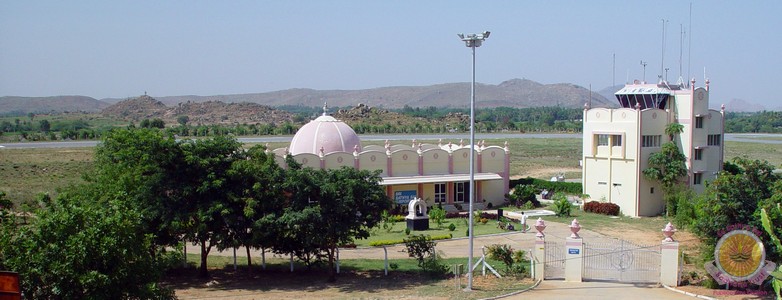 Sri
Sathya Sai Airport top
of page
Sri
Sathya Sai Airport top
of page
One kilometer from the super specialty hospital is the Sathya Sai airport, which was constructed in 1990. Flight routes and timings are subject to change, and flights takes place usually only in and around fesivals. Please call the airport phone 87346 or ask at the Indian Airlines Office in the ashram, N2 A1, phone 87444.
Two-three kilometers down the road, one makes a left turn onto the main road into Puttaparthy and ashram, Prasanthi Nilayam. After passing houses and all, one sees on the left:
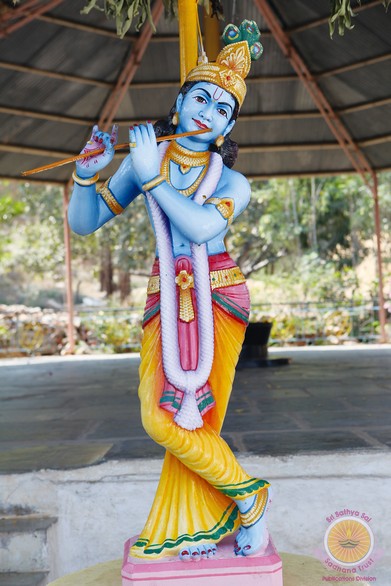 Gokulam
(The dairy) top
of page
Gokulam
(The dairy) top
of page
The ashram dairy is about half a kilometer from the ashram along the main
road. It has a beautiful image of Sri Krishna at the entrance, which Bhagawan
Baba Himself painted. You are requested not to go around the cowsheds
or disturb the animals.
Sri Sathya Sai International Centre for Sports top of page
Sri Sathya Sai International Centre for Sports – A state of art Olympic standard multi discipline indoor stadium with facilities for Basket ball, Volley ball, Tennis, Squash, Table tennis, Badminton, Gymnastics and Yoga/Aerobics was inaugurated on November 22, 2006, by the President of India, Hon’ble Dr. A.P.J. Abdul Kalam. This stadium measuring 100 metres by 60 metres on a 4.8 acre site is amongst the largest open frame space domes in the country/ (Built to Olympic specifications it can host international tournaments. Revered Chancellor has always championed the pursuit for excellence and as created a facility that will prepare sportspersons from all over the country to achieve great heights at the Global Sports Events.
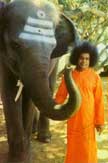 Sai Gita top
of page
Sai Gita top
of page
On the right, Sathya Sai Baba's pet elephant, Sai Gita, was kept. Sai Gita died several years ago, and a new elephant, Sathya Gita, is now here.. You are requested not to make any effort to go into
the stable or feed her. It is best to see her when she is taken out for
a walk or a bath. During various festivals at the ashram, she is richly
decorated and heads the colourful processions. You can see her at the
sports festival.
Sri Sathya Sai Vidya Giri
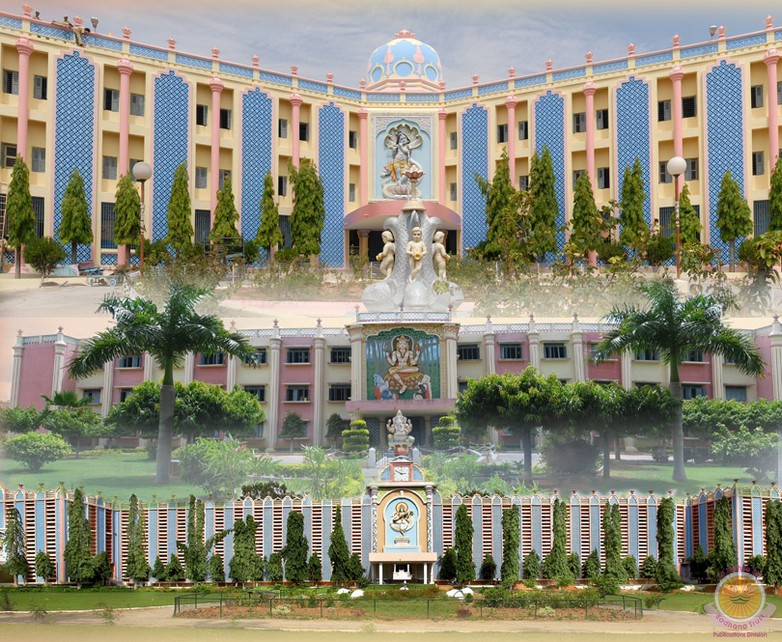 top
of page
top
of page
The buildings you see while approaching the Ashram as you come to Prasanthi Nilayam, on either side of the road are :
- Sri Sathya Sai Institute of Higher Learning (Prasanthi Nilayam Campus).
- Sri Sathya Sai Higher Secondary School.
- Sri Sathya Sai Primary School.
- Smt Easwaramma High School.
- The Old and New Hostels for boys.
- The music college (picture on the left).
Sri Sathya Sai Hill View Stadium top
of page
Located behind the Higher Secondary School, opposite the hill, towering with statues of Hanuman, Krishna, Shiva, Buddha, Zoroaster, and Christ, it gives an imposing view. Bhagawan Baba addresses the mammoth gathering, from the Shanthi Vedika (covered podium) on the Southern end of the stadium on His Birthday on 23rd November every year.
Sri Sathya Sai Hill View Stadium top of page
Located behind the Higher Secondary School, opposite the hill, towering with statues of Hanuman, Krishna, Shiva, Buddha, Zoroaster and Christ, it gives an imposing view. Bhagawan Baba addressed the mammoth gathering, from the Santhi Vedika (covered podium) on the Southern end of the stadium on His Birthday, 23 November, every year.
Among other events held here is the Annual Sports and Cultural meet for the Schools and Colleges on the 11 January . The Stadium is not open to public except when in use. An International Cricket Match for the Sri Sathya Sai Unity Cu. was held in this lush green stadium on 30 December 1997.Top Cricketers from India as well as from other cricket playing nations played in this exhibition match.
Planetarium top of page
You may get a glimpse of the planetarium. The Sri Sathya
Sai University is the first university in the country
to employ a planetarium for educational purposes. Its Space Theatre has
a capacity of 200. The well-equipped automatable,
multimedia planetarium chamber provides opportunities for multipurpose, interdisciplinary
use beyond the realm of astronomy. It is of immense educational value
for students and visitors.
The SPITZ SPACE SYSTEMS-512 planetarium instrument provides a star field of 4054 images including 88 recognized constellations
and 57 navigational stars, besides globular clusters and open clusters,
milky way, megallanic clouds, and nebulae. With the computer control and
over 30 special effect projectors, almost any celestial or meteorological
observation can be reproduced on the sky indoors. The tilted dome (hyposphere) permits unidirectional viewing
like any other theatre (e.g. cinema hall). The viewers observe events
in the same direction as they are sitting and at their eye level. Thus
they become participants in the programme.
In this "space age", the planetarium has assumed the position of a "space
science" laboratory as vital to the understanding of the physical universe
as the physics and chemistry laboratory.
In 2002, the Planetarium control system was upgraded to a completely computerized system, with an automation system developed in-house. In 2011, a full-dome projection system was incorporated using the mirror-dome technique.
Among the programmes contemplated for the entire range of education are
Night and Day, Solar System, Seasons, Constellations, and Zodiacal Signs
Located in rural surroundings, this planetarium aims to educate rural
masses on the latest developments in science and technology and help remove
superstition and blind faith through appropriately designed programmes.
Visitors are welcome to regular shows on the days shown below.. Entry begins at 10 am, show begins at 10.30 am. Duration of the show is approximately half an hour.
Tuesday - Hindi
Thursday - Hindi
Saturday - English
Sunday - Telugu
For more information, visit saispace.in.
Chaitanya
musuem top
of page
Inaugurated on 18 November, 2000 to commemorate the 75th year of the advent of Bhagawan Sri Sathya Sai Baba, this architectural marvel houses an exhibition on the Life and Mission of Bhagawan Sri Sathya Sai Baba. With multimedia presentations and fascinating exhibits arranged in seven phases, the museum takes the visitor through the story of Bhagawan’s birth and childhood, the prophecies connected with His Advent, and major milestones in the grand Mission of the Avatar.
Constructed on a hill slope, the building is a mosaic of different architectural styles and a fusion of the ancient and the modern.
- The roof, built in typical oriental fashion, is the biggest Chinese roof outside mainland China.
- Flanking the roof on both sides are two Moorish domes made of titanium.
- The crowning semicircular ends of the roof are adorned with Gothic arches.
- The two lift shafts have Japanese style roofs.
Apart from these features, it has extensive stapathi (traditional Indian carving) work done on flat surfaces, which vastly enhances the aesthetics of the building. Fiber optic lights fixed under the Chinese roof add to the beauty of the reflected decorative ceiling. The flooring inside consists of ceramic tiles, polished granite tiles in grey and red colours, Jaisalmer marble tiles and white glazed tiles.
The museum is open from 09:00 to 12:00 and 15:00 to 17:00 on all days except Mondays.
 As
you proceed along the main road, you will pass under an arch that has
the figure that you see on the right. Just after it, you'll see lots of
stores on the left and right. Further along, you'll see a road that leads
up the hill to the left. This road takes you to the following three sites.
As
you proceed along the main road, you will pass under an arch that has
the figure that you see on the right. Just after it, you'll see lots of
stores on the left and right. Further along, you'll see a road that leads
up the hill to the left. This road takes you to the following three sites.
Meditation Tree top of page
The Lord, who wrote a Divine Treatise on Meditation, titled Dhyana Vahini, with His Divine Fore vision, had planted a small sapling five decades ago on the idyllic hillock, at the eastern side of Prasanthi Mandir, precisely on 29 June 1959. Located on the left of the road uphill to the spiritual museum, it enhances the spiritual success of those who meditate under it. Visitors are allowed to meditate only during day time.
Prof. N. Kasturi in His book of commentary on ‘Sri Sathya Sai Ashtotharam’ writes thus on the great significance of the Vata Vriksha:
One Vaisakha Purnima day, years ago, Baba was on the sands of the River Chitravathi in the evening, with about a hundred Bhaktas. The talk inevitably moved towards Buddha whose birth, illumination and release happened on that day of the year. While speaking on the Bodhi Tree at Gaya to which Buddha proceeded for Thapas, someone asked, “why did he go so far and select that tree?” And Baba replied giving an account of mystic yanthras over which such trees grow, yanthras which keep out evil forces and stimulate spiritual impulses and help concentration. Even while He was describing these yanthras, He created from the sands a shining copper plate on which was drawn in squares the mystic symbols and numbers of which He spoke. He said that He would be depositing it in the Thapovana, (on the hills behind Prasanthi Nilayam) and plant a Vata Vriksha (Ficus Bengalensis) thereon. “It will act as the yanthra which I am describing. Yogis wherever they are, when they reach a certain stage of sadhana, will know of this congenial spot and hurry hither, to be benefited by this mystic potency”.
Sanathana Samskruthi Siritual
Museum top
of page
It is located on top of the hillock on the Southern side of the Ashram. Centered around the experience of spirituality in man’s evolution, it displays fascinating artifacts to convey the eternal message of saints and sages of all the religions of the world. Legends of Bhagawan Baba’s early life and His declaration of Avatarhood are emphasised in the displays. Sprawling over 20,000 square feet on three levels, it is designed to evoke the common spiritual quest of man, regardless of chronology or country. The architecture of this building is in the Shikara style as also the administrative building of the University. The Museum is open between 10-00 A.M. and 12 Noon on all days of the week except Wednesdays.
Administration
building top
of page
Sri Sathya Sai Institute of Higher Learning: The Administrative block of the University is a magnificent structure, located adjacent the museum. It stands as the sentinel of the happy amalgam of the secular and the spiritual, which is the foundation of the education system established by Bhagawan Sri Sathya Sai Baba. The Deemed University established in 1981 in the Vidya Giri conducts courses in undergraduate and postgraduate studies in Arts, Science and Professional subjects. Admission regulations, requests for application and prospectus are advertised in the Sanathana Sarathi, December and January every year. Devotees may however contact the Heads of these institutions while visiting Prasanthi Nilayam. Among the constituent colleges, are the Boys’ College in Whitefield and the Girls’ College in Anantapur. In consonance with Bhagawan Baba’s teachings, education in all these institutions is free.
Website: http://www.sssihl.edu.in
 Gopuram top
of page
Gopuram top
of page
Continuing along the main road, you finally come to the ashram and the
"Ganesh gate", so called because of the Ganesh statute inside.
This is where most people go in and out. Further down, you'll come to
the Gopuram (see the pic on the right). It was inaugurated just after
construction on 18 November 1975, during the 50th Birthday celebrations.
This imposing and inspiring "Gopuram" was built by devoted hands
in the South Indian style of temple architecture. Baba had the ancient
temples of Puttaparthi rebuilt, including the Gopalkrishna temple, associated
with its history through the ages. This is the entrance to the ashram
that Sai Baba uses, when He leaves or comes back by car. Directly inside
it is the main gate of the darshan area,
Sai Kulwant hall.
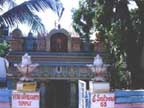 Village
Proper top
of page
Village
Proper top
of page
In the village proper, you'll see lots of stores, homes, hotels, and the
like, as well as old temples. As you go into the village, you can see
the Gopalaswami Temple (Lord Krishna as cowherd), the Hanuman Temple,
and a small temple of Sathyabhama (Divine Consort of Lord Krishna). There
is also an old mandir (temple) that is now called Pedda Venkappa
Raju Kalyana Mandapam. Itis used mainly as a wedding hall.
Samadhi Mandir top of page
The Samadhi (tomb) of Bhagawan’s physical parents, Sri Pedda Venkappa Raju and Smt. Easwaramma,is located in the Samadhi Road, a few yards from the Ganesh Gate. Every year during Eswaramma Day i.e. 6 May, special bhajans are conducted here and hundreds of poor people are fed.
Siva Mandir (Bhagawan’s Birth Place) top of page
The birthplace of Bhagawan Baba is now adorned by a Siva Temple, opened by Bhagawan in 1979. Puja (worship) is performed here every day at dawn and dusk. Legends of His birth and boyhood leelas can be visualised here.
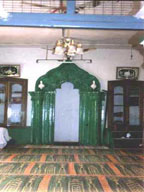 Mosque top
of page
Mosque top
of page
For the convenience of the local Muslim population, Bhagawan had a mosque
and a hall constructed and opened in 1978. Prayers are conducted regularly.
